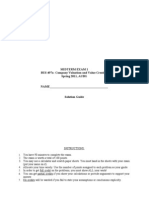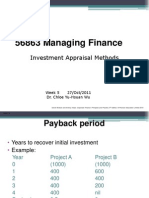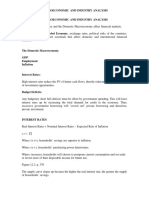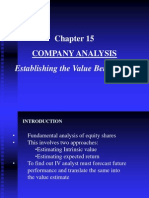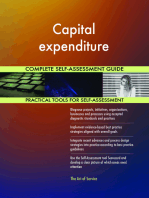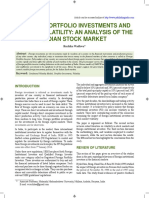BUS 497a - Homework 1 - Solution Guide
BUS 497a - Homework 1 - Solution Guide
Uploaded by
saltyaxelCopyright:
Available Formats
BUS 497a - Homework 1 - Solution Guide
BUS 497a - Homework 1 - Solution Guide
Uploaded by
saltyaxelOriginal Title
Copyright
Available Formats
Share this document
Did you find this document useful?
Is this content inappropriate?
Copyright:
Available Formats
BUS 497a - Homework 1 - Solution Guide
BUS 497a - Homework 1 - Solution Guide
Uploaded by
saltyaxelCopyright:
Available Formats
BUS 497a: Company Valuation and Value Creation Spring 2011, AUBG Solution Guide to HW# 1
Problem 1 Watson Dunn is planning to value BHP Billion Ltd. (NYSE: BHP) using a single stage FCFF approach. BHP Billion, headquartered in Melbourne, Australia, provides a variety of industrial metals and minerals. The financial information Dunn has assembled for his valuation is as follows: The company has 1,852 million shares outstanding. Market value of debt is $3.192 billion. FCFF is currently $1.1559 billion. Equity beta is 0.90, the equity risk premium is 5.5%, and the risk-free rate is 5.5%. The before tax cost of debt is 7.0%. The tax rate is 40%. To calculate WACC, assume the company is financed 25% with dent. FCFF growth rate is 4%. Using Dunn information, calculate: A. WACC B. Value of the firm C. Total Market value of equity D. Value per share Solution: A. The required return on equity is R = E(Ri) = Rf + i[E(Rm) Rf] = 5.5% + 0.90(5.5%) = 10.45% WACC = 0.25(7.0%)(1-0.40) + 0.75(10.45%) = 8.89% B. Firm Value = FCFF0(1+g)/(WACC-g) Firm Value = 1.1559(1.04)/0.0889 0.04) = $24.583 billion C. Equity Value = Firm Value Market Value of debt Equity Value = 24.583 3.192 = $21.391 billion D. Value per share = Equity Value/Number of shares
Value per share = 21.391/1.852 = $11.55
Problem 2 Kenneth McCoin is valuing McDonalds Corporation and performing a sensitivity analysis on his valuation. He uses a single stage FCFE growth model. The base case values for each of the parameters in the model are given in the table below, along with possible low and high estimates for each variable. Variable Normalized FCFE0 Risk-free rate Equity risk premium Beta FCFE perpetual growth rate Base Case Value $0.88 5.08% 5.50% 0.70 6.40% Low Estimate $0.70 5.00% 4.50% 0.60 4.00% High Estimate $1.14 5.20% 6.50% 0.80 7.00%
A. Use the base case values to estimate the current value of McDonalds Corporation. B. Calculate the range of stock prices that would occur if the base case value for FCFE0 were replaced by the low and high estimates for FCFE0. Similarly, using the base case values for all other variables, calculate the range of stock prices caused by the using the low and high values for beta, the risk-free rate, the equity risk premium, and the growth rate. Rank the sensitivity of the stock price to each of the five variables based on these ranges. Solution: A. Using CAPM, we find the required rate of return of McDonalds: R = E(Ri) = Rf + i[E(Rm) Rf] = 5.08% + 0.70(5.50%) = 8.93% The value per share is V0 = FCFE0 (1+g)/(r-g) = 0.88(1.064)/(0.0893 0.064) = $37.01 B. The table below shows the calculated price using base case values for all values except for the variable being changed from the base case value:
Variable
Est. Price with Low value
Est. Price with High value
Range (Rank)
Normalized FCFE0 Risk-free rate Equity Risk premium Beta FCFE perpetual growth rate
$29.44 $38.22 $51.17 $47.29 $18.56
$47.94 $35.33 $28.99 $30.40 $48.79
$18.50(3) $2.89(5) $22.18(2) $16.89(4) $30.23(1)
Problem 3 An aggressive financial planner who claims to have a superior method for picking undervalued stocks is courting of your clients. The planner claims that the best way to find the value of the stock is to divide EBITDA by the risk-free bond rate. The planner is urging your client to invest in Alcan, Inc. (NYSE: AL). Alcan is the parent of a group of companies engaged in all aspects of the aluminum business. The planner says that Alcans EBITDA of $1,580 million divided by the long-term government bond rate of 7% gives a total value of $22,571 million. With 380 million outstanding shares, Alcans value per share using this method is $70.98. Shares of Alcan currently trade for $36.50, and the planner wants your client to make a large investment in Alcan through him. A. Provide your client with an alternative valuation of Alcan based on a two-stage FCFE valuation approach. Use the following assumptions: Net Income is currently $600 million. Net income will grow by 20% annually for the next three years. The net investment in operating assets (capital expenditures less depreciation plus investment in working capital) will be $1,150 million next year and grow at 15% for the following two years. Forty percent of the net investment in operating assets will be financed with net new debt financing. Alcans beta is 1.3, the risk-free bond rate is 7%, and the equity risk premium is 4%. After three years, the growth rate of net income will be 8% and the net investment in operating assets (capital expenditures minus depreciation plus increase in working capital) each year will drop to 30% of net income. Debt is, and will continue to be 40% of total assets. Alcan has 318 million outstanding shares.
Find the value per share of Alcan.
B. Criticize the valuation approach that the aggressive financial planner used.
Solution: A. Using CAPM, we find the required rate of return: R = E(Ri) = Rf + i[E(Rm) Rf] = 7% + 1.3(4%) = 12.2% FCFE = Net Income (1-Debt Ratio)(FCinv. - Depreciation) (1-DebtRatio)(WCinv.) Debt ratio is the new debt financing as a percentage of the net new investment in fixed capital and the increase in working capital. Year Net Income Inv. In operating assets Net debt financing FCFE PV of FCFE discounted at 12.2% 1 $720.00 1,150.00 460.00 30.00 26.74 2 $864.00 1,322.50 529.00 70.50 56.00 3 $1,036.80 1,520.88 608.35 124.27 87.98 4 $1,119.74 335.92 134.37 918.19
The value of FCFE after year 3 if found using the constant growth model: V3 = FCFE4/(r-g) = 918.19/(0.122 0.08) = $21,861.67 million The PV of value V3, discounted at 12.2% equals $ 15,477.64 million. The total value of equity, the PV of the first three years of FCFE plus the PV of V3 is $15,648.36 million. Dividing this number by the outstanding shares (318 million) gives a value per share of $49.21. B. The planners estimate of the share value of $70.98 is much higher than the FCFE model estimate of $49.21 for several reasons: taxes and interest expenses should be taken out, second EBITDA does not account for the companys reinvestment in operating assets, and it does not account for the companys capital structure. Finally, dividing the EBITDA by the bond rate commits major mistake as well. The risk-free rate cant be used as a discount rate for risky equity cash flows. Problem 4 Bron has earning per share of $3.00 in 2002 and expect earnings per share to increase by 21% in 2003. Earnings per share are expected to grow at a decreasing rate for the following five years, as shown in the table below. In 2008, the growth rate will be 6% and is expected to stay at that rate thereafter. Net capital expenditures (capital expenditures minus depreciation) will be $ 5.00 per share in 2002 and then follow the pattern predicted in the table. In 2008, net capital
expenditures are expected to be $1.50 and will then grow at 6% annually. The investment in working capital parallels the increase in net capital expenditures each year. In 2008, investment in working capital will be $0.375 and is predicted to grow at 6% thereafter. Bron will use debt financing to fund 40% of net capital expenditures and 40% of the investment in working capital. Year Growth rate for earnings per share Net capital expenditure per share 2003 21% $5.00 2004 18% $5.00 2005 15% $4.50 2006 12% $4.00 2007 9% $3.50 2008 6% $1.50
The required rate of return for Bron is 12%. Find the value per share using a two-stage FCFE valuation approach. Solution: Year Growth rate for EPS EPS CAPEX per share Inv. In WC per share New debt financing=40% of (CAPEX WC inv.) FCFE = NI CAPEX WC inv. +New debt financing PV of FCFE discounted at 12% 2003 21% 3.630 5.000 1.250 2.500 -0.120 -0.107 2004 18% 4.283 5.000 1.250 2.500 0.533 0.425 2005 15% 4.926 4.500 1.125 2.250 1.551 1.104 2006 12% 5.517 4.000 1.000 2.000 2.517 1.600 2007 9% 6.014 3.500 0.875 1.750 3.389 1.923 2008 6% 6.374 1.500 0.375 0.750 5.249
Using the constant growth model, we can find the value of equity from 2008 onward: V2007 = FCFE2008/(r-g) = 5.249/(0.12 0.06) = $87.483 The PV of this stream is $87.483/1.12^5 = $49.640. The value per share is the value of the first five FCFE (2003-2007) plus the PV of the FCFE after 2007, or $4.944+$49.483 = $54.58
You might also like
- CarltonDocument5 pagesCarltonRaph AcuñaNo ratings yet
- SPACE Matrix of Microsoft CorpDocument2 pagesSPACE Matrix of Microsoft CorpJaja HollaNo ratings yet
- 7.7: Government Intervention in Response To Abuse of Market PowerDocument4 pages7.7: Government Intervention in Response To Abuse of Market PowerSimna Sarah StephenNo ratings yet
- Assignment Capital Budgeting Mini ProjectDocument2 pagesAssignment Capital Budgeting Mini ProjectArslanNo ratings yet
- JKhoggesDocument6 pagesJKhoggesDegrace NsNo ratings yet
- Cost of Capital - Exercises - 2019Document5 pagesCost of Capital - Exercises - 2019노대한No ratings yet
- Stock-Trak Project Final Preparation GuidlinesDocument1 pageStock-Trak Project Final Preparation GuidlinesKim Yoo SukNo ratings yet
- Lec 2 Delineating Efficient Portfolios The Shape of The Mean Variance Frontier 20160515111159Document33 pagesLec 2 Delineating Efficient Portfolios The Shape of The Mean Variance Frontier 20160515111159frq qqrNo ratings yet
- 05 Exercises On Capital BudgetingDocument4 pages05 Exercises On Capital BudgetingAnshuman AggarwalNo ratings yet
- Dell Sustainability Case AnalysisDocument1 pageDell Sustainability Case Analysisabhishek nigamNo ratings yet
- BFF5270 Topic 4 Tutorial QuestionsDocument6 pagesBFF5270 Topic 4 Tutorial QuestionsmattNo ratings yet
- CV Midterm Exam 1 - Solution GuideDocument11 pagesCV Midterm Exam 1 - Solution GuideKala Paul100% (1)
- Prior Exam 3Document9 pagesPrior Exam 3Brian WangNo ratings yet
- Corporate Finance, Home AssignmentDocument17 pagesCorporate Finance, Home Assignmentsyedsuhail20014u8724100% (9)
- Residual Income Valuation - UrpDocument18 pagesResidual Income Valuation - Urparmando.chappell1005100% (1)
- Lecture+4+Investment+Appraisal+Mehtods+11 12Document25 pagesLecture+4+Investment+Appraisal+Mehtods+11 12Mahajan AjayNo ratings yet
- Assignment QuestionsDocument5 pagesAssignment QuestionsRAJAT BANSAL0% (1)
- Coca-Cola Financial AnalysisDocument6 pagesCoca-Cola Financial AnalysisAditya Pal Singh Mertia RMNo ratings yet
- Chapter 1Document27 pagesChapter 1Nicole JoanNo ratings yet
- NPV Graph and SpreadsheetsDocument3 pagesNPV Graph and SpreadsheetsSrinivas Meduri100% (1)
- Macroeconomic and Industry AnalysisDocument4 pagesMacroeconomic and Industry AnalysisFajar TaufiqNo ratings yet
- R22 Capital Structure Q Bank PDFDocument6 pagesR22 Capital Structure Q Bank PDFZidane KhanNo ratings yet
- Sensitivity AnalysisDocument23 pagesSensitivity AnalysisKamrul Hasan0% (1)
- Optional Maths Revision Tutorial Questions: X X X A A A A A ADocument44 pagesOptional Maths Revision Tutorial Questions: X X X A A A A A ASaizchiNo ratings yet
- M&a Pepsico Final Report Sample AssignmentDocument23 pagesM&a Pepsico Final Report Sample AssignmentIndranil GangulyNo ratings yet
- Interest Rates and BondsDocument7 pagesInterest Rates and BondsMarlon A. RodriguezNo ratings yet
- Chapter 15 Company AnalysisDocument52 pagesChapter 15 Company AnalysisSamantha WrightNo ratings yet
- Financial Analysis of Coca Cola CompanyDocument22 pagesFinancial Analysis of Coca Cola CompanyCedric Ajodhia100% (1)
- Theory Efficient FrontierDocument6 pagesTheory Efficient FrontierJose ArmandoNo ratings yet
- Chapter 1 & 2 CompleteDocument81 pagesChapter 1 & 2 CompleteAmanda DrainvilleNo ratings yet
- Research QuestionsDocument37 pagesResearch QuestionsAmmar HassanNo ratings yet
- Chapter 1: The Investment Environment: Problem SetsDocument6 pagesChapter 1: The Investment Environment: Problem SetsMehrab Jami Aumit 1812818630No ratings yet
- Carillion Collapse: (CITATION Col18 /L 2057)Document6 pagesCarillion Collapse: (CITATION Col18 /L 2057)Nurjis AzkarNo ratings yet
- VolvoDocument16 pagesVolvoSatpal Daryanani100% (1)
- FINMAN TB Chapter13 Capital Structure and LeverageDocument32 pagesFINMAN TB Chapter13 Capital Structure and Leveragechin mohammadNo ratings yet
- Cost of CapitalDocument15 pagesCost of Capitalসুজয় দত্তNo ratings yet
- Mportance OF Apital UdgetingDocument16 pagesMportance OF Apital UdgetingtsayuriNo ratings yet
- New Heritage Doll Company Case StudyDocument10 pagesNew Heritage Doll Company Case StudyRAJATH JNo ratings yet
- Investment and Portfolio Management AssignmentDocument29 pagesInvestment and Portfolio Management AssignmentLiaNo ratings yet
- Finance Final ExamDocument3 pagesFinance Final Exambips99No ratings yet
- Capital BudgetingDocument5 pagesCapital Budgetingshafiqul84No ratings yet
- Capital Budgeting Techniques PDFDocument57 pagesCapital Budgeting Techniques PDFMecheal ThomasNo ratings yet
- Corporate Valuation Methods PDFDocument28 pagesCorporate Valuation Methods PDFHarsh Vora0% (1)
- CF Berk DeMarzo Harford Chapter 13 Problem AnswerDocument9 pagesCF Berk DeMarzo Harford Chapter 13 Problem AnswerRachel Cheng0% (1)
- Solutions For Chapter 6&7 Operations MGMTDocument14 pagesSolutions For Chapter 6&7 Operations MGMTleeladonNo ratings yet
- Analysis of Financial StatementsDocument33 pagesAnalysis of Financial StatementsKushal Lapasia100% (1)
- Libby Financial Accounting Chapter9Document11 pagesLibby Financial Accounting Chapter9Jie Bo Ti50% (2)
- SEx 6Document39 pagesSEx 6Amir Madani100% (1)
- M C R E ,: Inicase: Onch Epublic LectronicsDocument4 pagesM C R E ,: Inicase: Onch Epublic Lectronicsnara100% (3)
- Profitability AnalysisDocument9 pagesProfitability AnalysisAnkit TyagiNo ratings yet
- Sources of Finance (Equity)Document10 pagesSources of Finance (Equity)Dayaan ANo ratings yet
- Capital BudgetingDocument48 pagesCapital Budgetingkingword84% (19)
- Investment Project AnalysisDocument44 pagesInvestment Project AnalysisNgan Kim CaoNo ratings yet
- B.F. by S.K As at 5 May 2005Document355 pagesB.F. by S.K As at 5 May 2005John Munene Karoki100% (2)
- R D V Stock Preferred of ValueDocument42 pagesR D V Stock Preferred of ValueJesper N. Qvist100% (4)
- Paper 14 SolutionDocument23 pagesPaper 14 SolutionNisarg JoshiNo ratings yet
- Jan 2018Document34 pagesJan 2018alekhya manneNo ratings yet
- LyxorDocument64 pagesLyxorShaun WongNo ratings yet
- Fundamentals of Corporate Finance 8th Edition Brealey Test Bank PDFDocument79 pagesFundamentals of Corporate Finance 8th Edition Brealey Test Bank PDFa819334331No ratings yet
- Decoding DCF: A Beginner's Guide to Discounted Cash Flow AnalysisFrom EverandDecoding DCF: A Beginner's Guide to Discounted Cash Flow AnalysisNo ratings yet
- Ch-7-Revenue (Prashant Kirad)Document4 pagesCh-7-Revenue (Prashant Kirad)kanakchaurasia052No ratings yet
- Project Report On "Impact of Wto Agreement On Indian Agriculture"Document8 pagesProject Report On "Impact of Wto Agreement On Indian Agriculture"Teena VarmaNo ratings yet
- Bilet La Ordin InternationalDocument2 pagesBilet La Ordin InternationalGabriela ZsokNo ratings yet
- Applied Eco - PPT6Document71 pagesApplied Eco - PPT6Jane BañaresNo ratings yet
- (Pranav K Desai) Agricultural Economics (BookFi)Document317 pages(Pranav K Desai) Agricultural Economics (BookFi)Arpi JainNo ratings yet
- Sports Industry in IndiaDocument13 pagesSports Industry in Indiakissi shekherNo ratings yet
- FutureBuilders StrategyDocument2 pagesFutureBuilders StrategyMohammad RizaNo ratings yet
- Dubai Islamic Bank PakistanDocument65 pagesDubai Islamic Bank PakistanKâíñåt KháànNo ratings yet
- 1 The Following BreakDocument6 pages1 The Following BreakKaskas NikolaNo ratings yet
- Research MethodologyDocument3 pagesResearch MethodologyPatel_tarang43100% (2)
- Trade Online Introduction To Trade OnlineDocument7 pagesTrade Online Introduction To Trade Onlinesales MPNo ratings yet
- Manufacturing Accounts NotesDocument9 pagesManufacturing Accounts NotesFegason FegyNo ratings yet
- Options Strategies For A Range Bound ViewDocument11 pagesOptions Strategies For A Range Bound ViewAshutosh ChauhanNo ratings yet
- 4P GotchaDocument2 pages4P GotchaHai Viet TrieuNo ratings yet
- 2023 - Tutorial 11 - Dividend PolicyDocument3 pages2023 - Tutorial 11 - Dividend PolicyKarry hằngNo ratings yet
- Enterprises: Fullwon Philippines LTD., IncDocument13 pagesEnterprises: Fullwon Philippines LTD., IncBanoyJellie CañeteNo ratings yet
- WTC 1 Spring 2021 Session 14 04.05.2021Document28 pagesWTC 1 Spring 2021 Session 14 04.05.2021Dhruvin ManekNo ratings yet
- Shubhankar Corp Law 1 ProjectDocument24 pagesShubhankar Corp Law 1 ProjectShubhankar ThakurNo ratings yet
- Persistent Poverty in A Smug MeritocracyDocument2 pagesPersistent Poverty in A Smug MeritocracyKostasBaliotisNo ratings yet
- Bannari Amman Sugars LimitedDocument74 pagesBannari Amman Sugars LimitedSanthoshkumar ThangavelNo ratings yet
- Crowe Malaysia IPO Booklet 2022Document38 pagesCrowe Malaysia IPO Booklet 2022Ahmad Hakimi TajuddinNo ratings yet
- Model Question Paper of IBDocument5 pagesModel Question Paper of IBazam49100% (1)
- BCG Et Circularity Report DigitalDocument44 pagesBCG Et Circularity Report Digitalchahal.manjotNo ratings yet
- Project Proposal About Sari-Sari StoreDocument7 pagesProject Proposal About Sari-Sari StoreArcNo ratings yet
- Research Paper On FIIDocument7 pagesResearch Paper On FIIchitkarashellyNo ratings yet
- Encep Suryana Indonesia: Perum Griya Permata 2 Kopkarin Blok A8 Gunungmanik, TanjungsariDocument1 pageEncep Suryana Indonesia: Perum Griya Permata 2 Kopkarin Blok A8 Gunungmanik, TanjungsariEncep SuryanaNo ratings yet
- Quiz 3 STMGMTDocument3 pagesQuiz 3 STMGMTJoetta BlevinsNo ratings yet
- Bank of America Case AnalysisDocument11 pagesBank of America Case Analysiskanabaramit67% (3)












